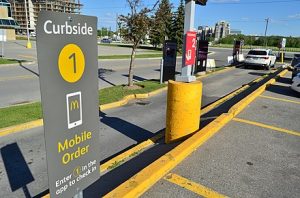Chapter 10 – Health, Safety and Security
Pauline Milwood
The way organizations deal with their customers, their employees, and the broader community in a crisis is likely to leave lasting memories in customers’ minds.
—Rachel Deibner, Elizabeth Silliman, Kelly Ungerman, and Maxence Vancauwenberghe, “Adapting Customer Experience in the Time of Coronavirus”
Learning Objectives
At the end of this chapter, students will be able to do the following:
- Understand and apply University Policy AD26 guidelines for the sale and serving of food and beverages at university locations
- Understand and apply state and local food safety and sanitation guidelines for implementing pop-up restaurants
- Understand and apply health and food safety practices for managers and employees in the post-COVID-19 (SARS-CoV-2) pandemic era
- Create a food health and safety plan for operating a pop-up restaurant
Chapter Warm-Up
Prechapter Reading Materials
- “Torn between Safety and Environmental Concerns, Restaurants Stick with Disposable Serveware” (Hartke 2020)
- “AD26 Sale and Serving of Food and Beverages at University Locations” (Penn State University 2013)
- “Best Practices for Re-opening Retail Food Establishments during the COVID-19 Pandemic: Food Safety Checklist” (US Food and Drug Administration 2020)
- “Covid-19 Operating Guidance” (National Restaurant Association 2021)
- “Responding to COVID-19 in Pennsylvania” (Commonwealth of Pennsylvania 2022)
Prechapter Exercises
- Conduct a short interview about safety and dining out with the person seated to your immediate right or left. In your interview, please include the following three questions:
- Have you dined out since the start of the pandemic?
- How do you feel about current health and food safety standards and practices since the COVID-19 pandemic?
- As a hospitality management student preparing to graduate, how will you help dine-in guests feel comfortable if they decide to attend your pop-up restaurant?
- Review the 2022 State of the Restaurant Industry report. In groups of two to three persons, identify and discuss key aspects of consumer sentiments and intentions as they relate to dining out.
Chapter Outline
- Background
- COVID-19 (SARS-CoV-2) and Implications for Food Production and Service
- Penn State University Policy AD26
- Implications for Managers and Employees
Background
Historically, the focus of food safety within the restaurant industry has been almost exclusively on how to avoid an outbreak of a foodborne illness. To this end, commercial food establishments have designed food safety and management training programs around preventing food hazards, cross-contamination, and time-temperature abuse of potentially hazardous foods. The National Restaurant Association is an umbrella organization representing the interests of some four hundred thousand restaurants and is perhaps the foremost organization for food safety training, which it administers through its ServSafe education program. More recently, food safety has expanded its focus to person-to-person contact, which traditionally occurs in service encounters.
COVID-19 (SARS-CoV-2) and implications for food production and service
In the wake of the 2020 global COVID-19 pandemic and in an effort to mitigate the spread of the disease caused by the novel coronavirus, additional layers of safety protocols have been introduced. Requirements put in place by several restaurants include guests wearing masks except while actively dining, the admittance of only guests who can show evidence of vaccination, social distancing, and capacity limits.
Restaurants also implemented business models and operational changes in response to the pandemic. Some of these changes included contactless payment and delivery, curbside pickup, and the rise of ghost or virtual kitchens.

Image credit: “ATAR band, the brazilian smartband that make contactless payments” by Mikeallanpellin via Wikimedia Commons under CC BY-SA 4.0.

Image credit: “McDonalds Curbside Pickup Markham Town Square” by Raysonho via Wikimedia Commons under CC0.
In addition to the reopening guidance provided by the National Restaurant Association, food-service managers should also do the following:
- Ensure their team leads are ServSafe manager certified
- Provide ServSafe food handler training
- Provide technology-supported systems
- Follow all applicable guidelines provided by local, state, and federal regulatory agencies
Penn State University Policy AD26
The Advanced Food Production and Service Management (HM 430) requirement for staging a pop-up restaurant at Penn State Berks is governed by Penn State University’s Policy AD26. Soon-to-be graduating seniors should familiarize themselves with the policy to ensure that all planning and implementation activities abide by the university’s guidelines for the sales and service of food and beverage at campus locations. The policy is summarized below:
The purpose of Policy AD26 governing Sale and Service of Food and Beverages at University Locations is to outline the responsibilities of the University in providing and approving food and beverage services, as well as recognize the contractual responsibilities and limitations of the University for the provision of beverages and vended products on University owned and leased property. The Director of Housing and Food Services (or their designee) or The Director of Business Services (or their designee) can authorize an exception in advance of the event if University Food Services does not have the culinary arts expertise required for the successful execution of the event.
Implications for Managers and Employees
- The COVID-19 pandemic brought about several new health and safety implications for hospitality workers, particularly for those working in restaurants and commercial food-service establishments. While some of these implications have been favored by the industry as a whole (e.g., business model innovations, improved working conditions), others have resulted in the departure of millions of hospitality workers from the industry, part of a global trend largely referred to as the “Great Resignation.”Other implications for student managers, team members, and the volunteers and community partners supporting their pop-up restaurant projects include the following:
- Conflict-resolution training. Be prepared to encounter and resolve conflicts with angry or resentful pop-up diners who do not agree with mask-wearing policies or vaccine requirements as a method of mitigating COVID-19 spread.
- Entrepreneurial mind-set. Employ dynamic approaches to venue layout and design to adhere to capacity and/or operating restrictions as well as to ensure social distance among diners.
- Shared service design. For larger, mixed audiences, consider menu portions and plating designs that minimize guests engaging in shared-plate services and self-help food-service styles.
- Venue and servicescape innovations. Take advantage of nontraditional use spaces such as outdoor green space during warmer months, indoor garages, barns, unutilized factory spaces, and underutilized kitchen spaces.
KEY TERMS
- Contactless
- COVID-19
- Curbside to-go
- SARS-CoV-2
- University Policy AD26
REVIEW Questions
- In mid-2020, Tripadvisor began displaying COVID-19 safety protocol information for restaurants. A cursory check of restaurant websites suggests the practice has become less popular. Do you think this information is/was helpful to customers? Why or why not?
- When planning and designing a pop-up restaurant, what are some environmental concerns that should be considered? How might these concerns conflict with safety concerns?
- Describe any experience with or observation of a difficult situation in your workplace arising from differences in patron or employee sentiment on mask wearing or other COVID-19 guidelines.
- What are some of the implications of University Policy AD26 for implementing a safety plan for a campus-based pop-up restaurant?
- How has COVID-19 impacted the planning and implementation of a pop-up restaurant? Discuss implications of COVID-19 on planning and designing a pop-up space for safety.
Review Activities
- Type the name of your favorite restaurant in your internet browser. Take a moment to view the restaurant’s publicly accessible information related to COVID-19 restrictions and guidelines for doing business with the restaurant. Does the restaurant provide any information related to COVID-19? If yes, what type of information is provided? Form groups of three to five members and spend five to ten minutes discussing your findings.
- In their 2021 article entitled “Culinary Tourism and Post-pandemic Travel: Ecosystem Responses to an External Shock,” Milwood and Crick (2021) found that larger hotel restaurants and eponymous restaurants (i.e., restaurants named after a public figure or celebrity), when compared with smaller establishments, displayed COVID-19 safety information more consistent with and similar to information found on travel destination websites. Why do you think this difference in COVID-19 safety information occurs between these commercial food-service establishments?
Pop-up Project Task
- Develop food safety and implementation plans within the context of new state and local COVID-19 guidelines.
Resources
Chapter References
Commonwealth of Pennsylvania. 2022. “Responding to COVID-19 in Pennsylvania.” Last modified April 11, 2022. https://www.pa.gov/guides/responding-to-covid-19/.
Diebner, Rachel, Elizabeth Silliman, Kelly Ungerman, and Maxence Vancauwenberghe. 2020. “Adapting Customer Experience in the Time of Coronavirus.” McKinsey & Company. Last modified April 2, 2020. https://www.mckinsey.com/business-functions/growth-marketing-and-sales/our-insights/adapting-customer-experience-in-the-time-of-coronavirus.
Hartke, Kristen. 2020. “Torn between Safety and Environmental Concerns, Restaurants Stick with Disposable Serveware.” Washington Post, October 21, 2020. https://www.washingtonpost.com/food/2020/10/21/restaurant-utensils-coronavirus-safety/.
Heil, Emily. 2020. “Diners Angry about Masks and Other Coronavirus Rules Prompt Training for Restaurant Workers.” Washington Post, September 22, 2020. https://www.washingtonpost.com/news/voraciously/wp/2020/09/22/diners-angry-about-masks-and-other-coronavirus-rules-prompt-training-for-restaurant-workers/.
Milwood, Pauline, and Anne P. Crick. 2021. “Culinary Tourism and Post-pandemic Travel: Ecosystem Responses to an External Shock.” Journal of Tourism, Heritage & Services Marketing 7 (1): 23–32. https://ssrn.com/abstract=3783682.
Moreo, Andrew, Imran Rahman, Lisa Cain, and Trishna G. Mistry. 2022. “Bad Managers, Burnout, and Health Fears: Why Record Numbers of Hospitality Workers Are Quitting the Industry for Good.” Conversation, February 2, 2022. https://theconversation.com/bad-managers-burnout-and-health-fears-why-record-numbers-of-hospitality-workers-are-quitting-the-industry-for-good-174588.
National Restaurant Association. 2020. “New Normal Inspires New Innovations in Restaurant Industry.” Last modified October 14, 2020. https://restaurant.org/education-and-resources/resource-library/new-normal-inspires-new-innovations-in-restaurant-industry/.
———. 2021. “Covid-19 Operating Guidance.” Last modified July 2021. https://go.restaurant.org/covid19-reopening-guide.
Pendrill, Katherine. n.d. “9 Tips for Curbside Pickup Restaurant Operations.” TouchBistro. Accessed January 17, 2022. https://www.touchbistro.com/blog/guide-to-restaurant-curbside-pickup/.
Penn State University. 2013. “AD26 Sale and Serving of Food and Beverages at University Locations.” Administrative Policies. Last modified June 19, 2013. https://policy.psu.edu/policies/ad26.
ServSafe. 2022. Accessed January 17, 2022. https://www.servsafe.com/.
Sink, Vanessa. 2022. “National Restaurant Association Releases 2022 State of the Restaurant Industry Report: 2022 Remains Year of Transition as Path to Recovery Continues; Labor Challenges a Top Concern for Operators.” PR Newswire, February 1, 2022. https://restaurant.org/research-and-media/media/press-releases/association-releases-2022-state-of-the-restaurant-industry-report/ (Penn State–authenticated link).
US Food and Drug Administration. 2020. “Best Practices for Re-opening Retail Food Establishments during the COVID-19 Pandemic: Food Safety Checklist.” Last modified June 1, 2020. https://www.fda.gov/food/food-safety-during-emergencies/best-practices-re-opening-retail-food-establishments-during-covid-19-pandemic.
Wikipedia. n.d.-a. “Contactless Payment.” Accessed April 14, 2022. https://en.wikipedia.org/wiki/Contactless_payment.
———. n.d.-b. “National Restaurant Association.” Accessed April 14, 2022. https://en.wikipedia.org/wiki/National_Restaurant_Association.

